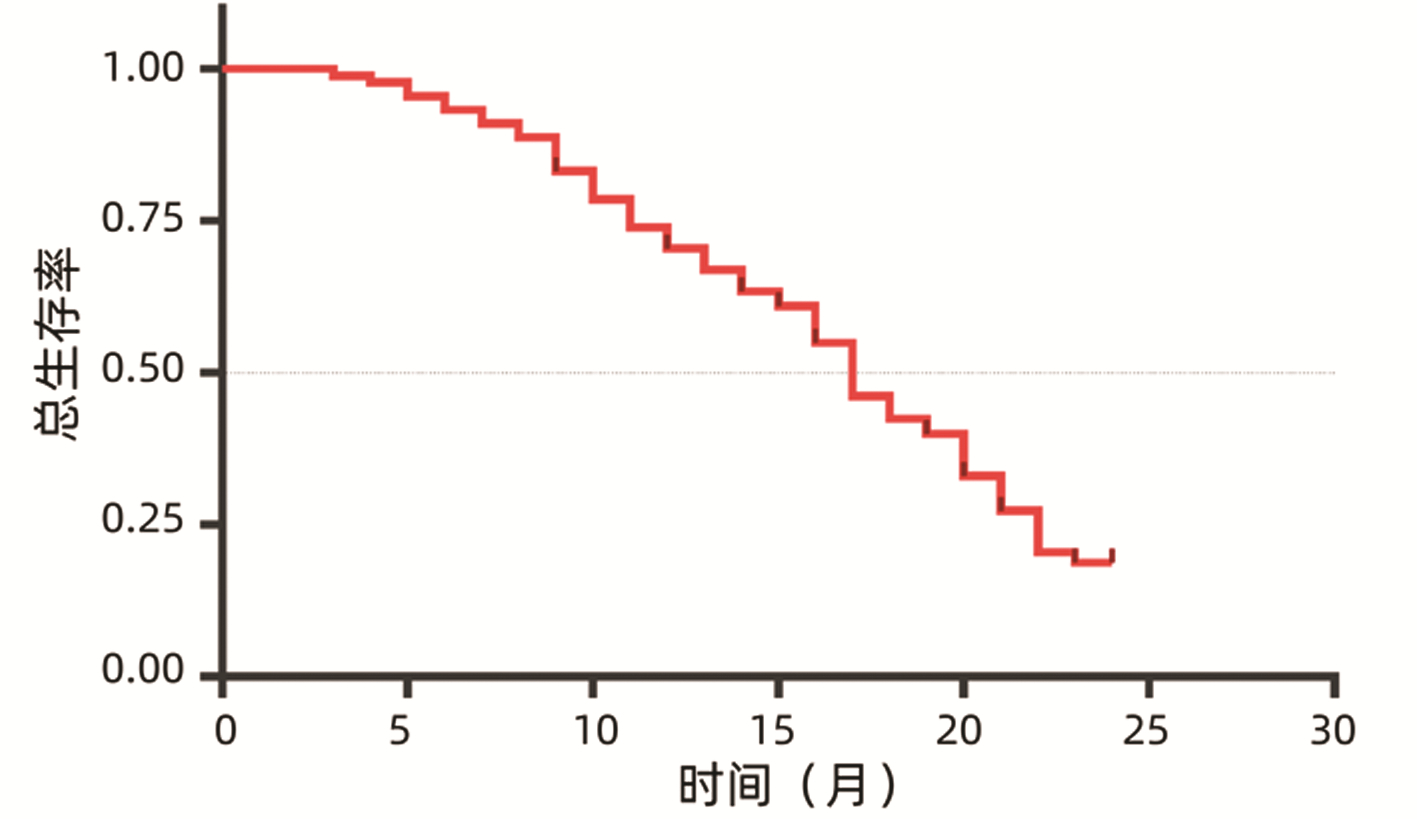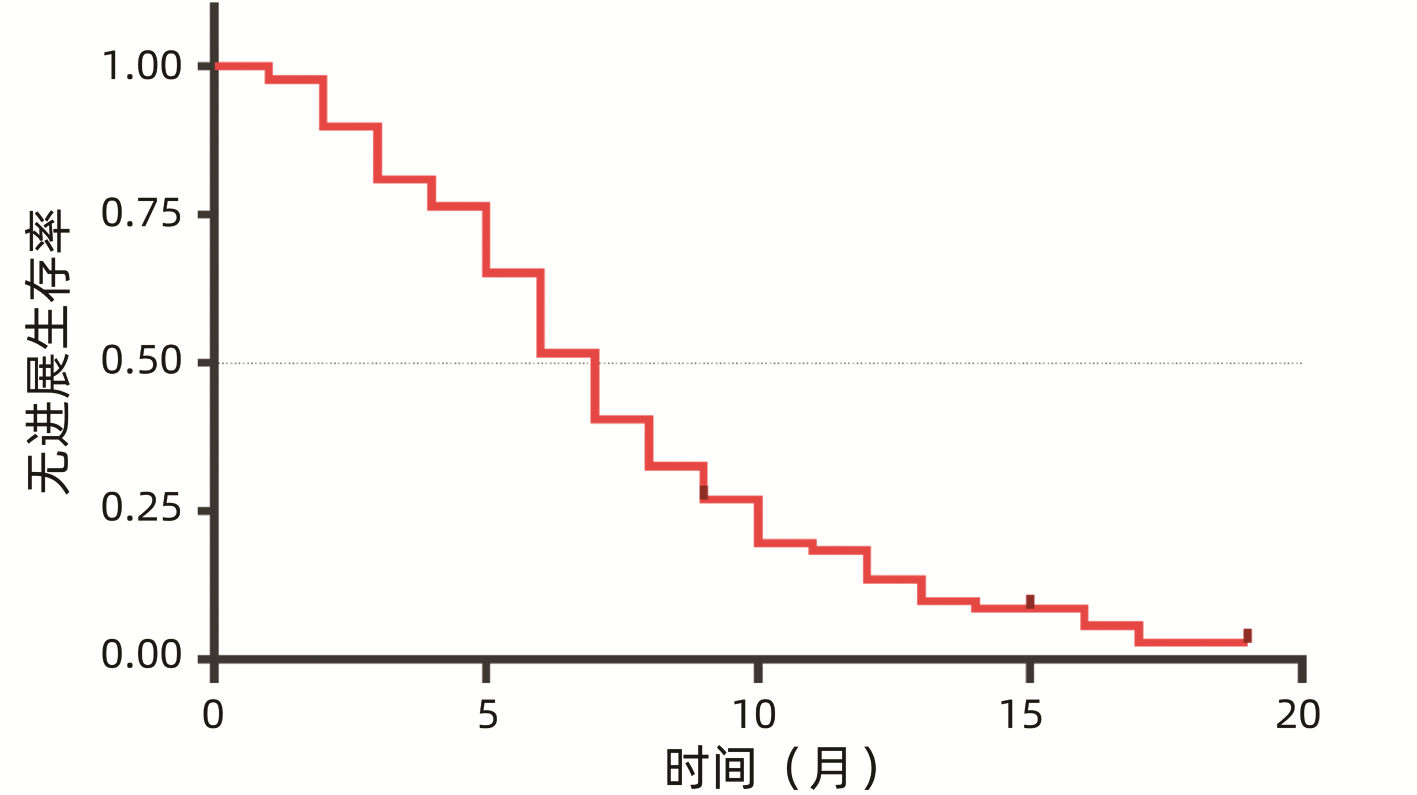载药栓塞微球经肝动脉化疗栓塞术联合阿帕替尼治疗不可切除肝癌后二线追加卡瑞利珠单抗的安全性和有效性分析
DOI: 10.3969/j.issn.1001-5256.2023.04.014
Safety and efficacy of camrelizumab added to second-line therapy after drug-eluting bead transarterial chemoembolization combined with apatinib for unresectable hepatocellular carcinoma
-
摘要:
目的 分析在载药栓塞微球经肝动脉化疗栓塞术(DTACE)联合阿帕替尼治疗不可切除肝癌后,二线追加卡瑞利珠单抗的安全性和有效性。 方法 回顾性分析2019年12月—2020年12月于郑州大学第一附属医院就诊的89例二线追加卡瑞利珠单抗的肝癌患者资料。主要观察终点是使用卡瑞利珠单抗后总生存期(OS)和无进展生存期(PFS),次要终点包括客观缓解率(ORR)、疾病控制率(DCR)和治疗相关不良事件(TRAE)。采用Kaplan-Meier法估算生存曲线,基线特征亚组分层分析采用Log-rank检验进行比较,分析影响患者预后的相关因素。 结果 本研究共筛选并随访了89例患者。随访至2021年12月,中位随访时间为16个月,中位OS为17.0(95%CI:15.3~18.7)个月,中位PFS为7.0(95%CI:6.2~7.8)个月。不同ECOG-PS、肝功能Child-Pugh分级、门静脉侵犯、进展模式、DTACE次数、口服阿帕替尼时长和应用卡瑞利珠单抗时长的患者OS及PFS之间差异具有统计学意义(P值均<0.05)。应用卡瑞利珠单抗后3个月与6个月ORR分别为39.3%和22.4%,DCR分别为80.9%和54.1%。Log-rank检验单因素分析结果表明:DTACE次数为3~4、1~2比0次的患者显著改善中位OS [22.0 (95%CI:21.1~22.9)个月vs 17.0 (95%CI:15.8~18.2)个月vs 10.0 (95%CI:7.0~13.0)个月, χ2=31.423,P<0.001]与PFS [10.0 (95%CI:7.0~13.0)个月vs 7.0(95%CI:6.2~7.8)个月vs 3.0 (95%CI:1.9~4.1)个月, χ2=20.741,P<0.001]; 阿帕替尼应用时长>4个月比≤4个月的患者显著改善中位OS [21.0 (95%CI:19.1~22.9) 个月vs 14.0(95%CI:10.4~17.6)个月, χ2=19.399,P<0.001]与PFS [9.0 (95%CI:7.3~10.7)个月vs 5.0 (95%CI:4.0~6.0)个月, χ2=27.733,P<0.001]; 卡瑞利珠单抗应用时长>5个月比≤5个月的患者显著改善中位OS [22.0(95%CI:20.2~23.8)个月vs 13.0(95%CI:9.3~16.7)个月, χ2=22.336,P<0.001]与PFS [9.0 (95%CI:7.0~11.0)个月vs 5.0 (95%CI:4.1~5.9)个月, χ2=26.141,P<0.001]。DTACE术后不良事件为栓塞后综合征,给予对症处理后缓解。靶向药物和免疫治疗相关不良反应经对症支持治疗后均缓解,无4级及以上不良反应,无患者因TRAE而停用靶免治疗。 结论 DTACE联合阿帕替尼治疗不可切除肝癌进展后追加卡瑞利珠单抗疗效确切,TRAE总体安全可控。 Abstract:Objective To investigate the safety and efficacy of camrelizumab added to second-line therapy after drug- eluting bead transarterial chemoembolization (DTACE) combined with apatinib for unresectable hepatocellular carcinoma (HCC). Methods A retrospective analysis was performed for 89 HCC patients with camrelizumab added to second-line therapy who attended The First Affiliated Hospital of Zhengzhou University from December 2019 to December 2020. The primary endpoints were overall survival (OS) and progression-free survival (PFS) after the application of camrelizumab, and the secondary endpoints were objective remission rate (ORR), disease control rate (DCR), and treatment-related adverse events (TRAEs). The Kaplan-Meier method was used to plot survival curves, the Log-rank test was used for stratified analysis of subgroups based on baseline characteristics, and the influencing factors for prognosis were analyzed. Results A total of 89 patients were screened and followed up in this study. The patients were followed up to December 2021, with a median follow-up time of 16 months, a median OS time of 17.0 (95% confidence interval [CI]: 15.3-18.7) months, and a median PFS time of 7.0 (95% CI: 6.2-7.8) months. There were significant differences in OS and PFS between the patients with different ECOG-PS scores, liver function Child-Pugh classes, portal vein invasion, patterns of progression, times of DTACE treatment, durations of oral administration of apatinib, and durations of application of camrelizumab (all P < 0.05). At 3 and 6 months after the application of camrelizumab, ORR was 39.3% and 22.4%, respectively, and DCR was 80.9% and 54.1%, respectively. The univariate analysis using the Log-rank test showed that compared with the patients receiving 0 time of DTACE treatment, the patients receiving 3-4 or 1-2 times of DTACE treatment had significant improvements in median OS [22.0 (95% CI: 21.1-22.9) months and 17.0 (95% CI: 15.8-18.2) months vs 10.0 (95% CI: 7.0-13.0) months, χ2=31.423, P < 0.001] and PFS [10.0 (95% CI: 7.0-13.0) months and 7.0 (95% CI: 6.2-7.8) months vs 3.0 (95% CI: 1.9-4.1) months, χ2=20.741, P < 0.001]; compared with the patients using apatinib for ≤4 months, the patients using apatinib for > 4 months had significant improvements in median OS [21.0 (95% CI: 19.1-22.9) months vs 14.0 (95% CI: 10.4-17.6) months, χ2=19.399, P < 0.001] and PFS [9.0 (95% CI: 7.3-10.7) months vs 5.0 (95% CI: 4.0-6.0) months, χ2=27.733, P < 0.001]; compared with the patients using camrelizumab for ≤5 months, the patients using camrelizumab for > 5 months had significant improvements in median OS [22.0 (95% CI: 20.2-23.8) months vs 13.0 (95% CI: 9.3-16.7) months, χ2=22.336, P < 0.001] and PFS [9.0 (95% CI: 7.0-11.0) months vs 5.0 (95% CI: 4.1-5.9) months, χ2=26.141, P < 0.001]. Post-embolization syndrome was the adverse event after DTACE and resolved after symptomatic treatment. Adverse reactions related to targeted drugs and immunotherapy all resolved after symptomatic supportive treatment, with no grade ≥4 adverse reactions, and no patients withdrew from target-free therapy due to TRAEs. Conclusion As for DTACE combined with apatinib in the treatment of unresectable HCC, camrelizumab added after progression has a marked therapeutic efficacy with safe and controllable TRAEs. -
Key words:
- Liver Neoplasms /
- Chemoembolization, Therapeutic /
- Apatinib /
- Camrelizumab
-
表 1 患者临床基线特征
Table 1. Baseline characteristics of patients
临床特征 数据 性别[例(%)] 男 75(84.3) 女 14(15.7) ECOG-PS[例(%)] 0 35(39.3) 1 35(39.3) 2 19(21.3) Child-Pugh肝功能分级[例(%)] A级 51(57.3) B级 38(42.7) 甲胎蛋白[例(%)] ≤400 ng/mL 41(46.1) >400 ng/mL 48(53.9) 门静脉侵犯[例(%)] Vp1~2 71(79.8) Vp3 12(13.5) Vp4 6(6.7) 病因学[例(%)] 乙/丙型肝炎 68(76.4) 其他 21(23.6) 合并肝硬化[例(%)] 否 28(31.5) 是 61(68.5) 进展模式[例(%)] 靶区病灶 57(64.0) 非靶区病灶 23(25.8) 新发病灶 9(10.1) DTACE次数[例(%)] 0 19(21.3) 1~2 49(55.1) 3~4 21(23.6) 阿帕替尼应用时长[例(%)] ≤4个月 48(53.9) >4个月 41(46.1) 卡瑞利珠单抗应用时长[例(%)] ≤5个月 51(57.3) >5个月 38(42.7) 注: Vp, 日本肝细胞癌研究会门静脉癌栓分型。 表 2 影响患者OS的临床基线特征变量的单因素分析
Table 2. Univariate analysis of clinical baseline characteristic variables affecting OS
临床特征 中位OS (95%CI)
(月)χ2值 P值 性别 0.699 0.403 男 17.0 (15.4~18.6) 女 16.0 (5.9~26.1) ECOG-PS 10.961 0.004 0 20.0 (15.9~24.1) 1 17.0 (13.2~20.8) 2 10.0 (8.4~11.6) Child-Pugh分级 7.991 0.005 A级 20.0 (17.2~22.8) B级 13.0 (8.5~17.5) 甲胎蛋白 1.161 0.688 ≤400 ng/mL 16.0 (13.1~18.9) >400 ng/mL 17.0 (15.4~18.6) 门静脉侵犯 30.288 <0.001 Vp1~2 19.0 (17.0~21.0) Vp3 14.0 (8.7~19.3) Vp4 7.0 (3.4~10.6) 病因学 0.540 0.462 乙/丙型肝炎 17.0 (14.7~19.3) 其他 17.0 (15.7~18.3) 合并肝硬化 0.064 0.800 否 18.0 (13.4~22.6) 是 17.0 (14.8~19.2) 进展模式 7.689 0.021 靶区病灶 15.0 (12.5~17.5) 非靶区病灶 21.0 (18.1~23.9) 新发病灶 21.0 (19.6~22.4) DTACE次数 31.423 <0.001 0 10.0 (7.0~13.0) 1~2 17.0 (15.8~18.2) 3~4 22.0 (21.1~22.9) 阿帕替尼应用时长 19.399 <0.001 ≤4个月 14.0 (10.4~17.6) >4个月 21.0 (19.1~22.9) 卡瑞利珠单抗应用时长 22.336 <0.001 ≤5个月 13.0 (9.3~16.7) >5个月 22.0 (20.2~23.8) 表 3 影响患者PFS的临床基线特征变量的单因素分析
Table 3. Univariate analysis of clinical baseline characteristic variables affecting PFS
临床特征 中位PFS (95%CI)
(月)χ2值 P值 性别 0.016 0.898 男 6.0(5.0~7.0) 女 7.0(5.8~8.2) ECOG-PS 6.330 0.042 0 7.0(6.0~8.0) 1 7.0(5.7~8.3) 2 5.0(2.4~7.6) Child-Pugh分级 3.973 0.046 A级 7.0(5.3~8.7) B级 6.0(4.9~7.1) 甲胎蛋白 0.213 0.644 ≤400 ng/mL 6.0(4.6~7.4) >400 ng/mL 7.0(6.0~8.0) 门静脉侵犯 10.446 0.005 Vp1~2 7.0(5.8~8.2) Vp3 5.0(1.6~8.4) Vp4 4.0(0.4~7.6) 病因学 0.067 0.796 乙/丙型肝炎 7.0(6.1~7.9) 其他 6.0(3.8~8.2) 合并肝硬化 3.093 0.079 否 7.0(3.6~10.4) 是 7.0(6.1~7.9) 进展模式 6.586 0.037 靶区病灶 6.0(5.1~6.9) 非靶区病灶 9.0(6.7~11.3) 新发病灶 8.0(6.6~9.4) DTACE次数 20.741 <0.001 0 3.0(1.9~4.1) 1~2 7.0(6.2~7.8) 3~4 10.0(7.0~13.0) 阿帕替尼应用时长 27.733 <0.001 ≤4个月 5.0(4.0~6.0) >4个月 9.0(7.3~10.7) 卡瑞利珠单抗应用时长 26.141 <0.001 ≤5个月 5.0(4.1~5.9) >5个月 9.0(7.0~11.0) 表 4 首次输注卡瑞利珠单抗后3个月和6个月的治疗应答
Table 4. Treatment response at 3 and 6 months after first infusion of Camrelizumab
肿瘤应答评估 3个月
(n=89)6个月
(n=85)总体反应[例(%)] CR 12(13.5) 6(7.1) PR 23(25.8) 13(15.3) SD 37(41.6) 27(31.8) PD 17(19.1) 39(45.9) ORR(CR+PR)[例(%)] 35(39.3) 19(22.4) DCR(CR+PR+SD)[例(%)] 72(80.9) 46(54.1) 注: CR, 完全缓解; PR, 部分缓解; SD, 疾病稳定; PD, 疾病进展。 表 5 TRAE发生情况
Table 5. Treatment-related adverse events
TRAE 1~5级 3级 DTACE相关[例(%)] 发热 36(40.4) 0 疼痛 19(21.3) 3(3.4) 胃肠道反应 26(29.2) 0 肝脓肿 2(2.2) 2(2.2) 阿帕替尼/卡瑞利珠单抗相关[例(%)] 乏力 23(25.8) 0 手足综合征 17(19.1) 0 高血压 16(18.0) 0 肝性脑病 15(16.9) 4(4.5) 发热 11(12.4) 0 疼痛 10(11.2) 0 蛋白尿 5(5.6) 0 皮疹 3(3.4) 0 甲状腺功能异常 3(3.4) 0 反应性皮肤毛细血管增生症 14(15.7) 0 骨髓抑制 1(1.1) 0 免疫相关肺炎 1(1.1) 1(1.1) 上消化道出血 7(7.9) 3(3.4) 注: 根据CTCAE 4.03评估AE。 -
[1] SUNG H, FERLAY J, SIEGEL RL, et al. Global Cancer Statistics 2020: GLOBOCAN Estimates of incidence and mortality worldwide for 36 cancers in 185 countries[J]. CA Cancer J Clin, 2021, 71(3): 209-249. DOI: 10.3322/caac.21660. [2] VILLANUEVA A. Hepatocellular carcinoma[J]. N Engl J Med, 2019, 380(15): 1450-1462. DOI: 10.1056/NEJMra1713263. [3] VESSELLE G, QUIRIER-LELEU C, VELASCO S, et al. Predictive factors for complete response of chemoembolization with drug-eluting beads (DEB-TACE) for hepatocellular carcinoma[J]. Eur Radiol, 2016, 26(6): 1640-1648. DOI: 10.1007/s00330-015-3982-y. [4] SONG MJ, CHUN HJ, SONG DS, et al. Comparative study between doxorubicin-eluting beads and conventional transarterial chemoembolization for treatment of hepatocellular carcinoma[J]. J Hepatol, 2012, 57(6): 1244-1250. DOI: 10.1016/j.jhep.2012.07.017. [5] CAO B, ZHANG GW. Meta analysis of efficacy and safety of drug-eluting beads transarterial chemoembolization and conventional transarterial chemoembolization in the treatment of advanced hepatocellular carcinoma[J]. China Med Herald, 2021, 18(26): 95-99. https://www.cnki.com.cn/Article/CJFDTOTAL-YYCY202126023.htm曹博, 张光文. 载药微球经动脉化疗栓塞术与常规经动脉化疗栓塞术治疗中晚期肝癌效果及安全性的meta分析[J]. 中国医药导报, 2021, 18(26): 95-99. https://www.cnki.com.cn/Article/CJFDTOTAL-YYCY202126023.htm [6] SCARTOZZI M, BARONI GS, FALOPPI L, et al. Trans-arterial chemo-embolization (TACE), with either lipiodol (traditional TACE) or drug-eluting microspheres (precision TACE, pTACE) in the treatment of hepatocellular carcinoma: efficacy and safety results from a large mono-institutional analysis[J]. J Exp Clin Cancer Res, 2010, 29(1): 164. DOI: 10.1186/1756-9966-29-164. [7] ZHOU GH, HAN J, SUN JH, et al. Efficacy and safety profile of drug-eluting beads transarterial chemoembolization by CalliSpheresⓇ beads in Chinese hepatocellular carcinoma patients[J]. BMC Cancer, 2018, 18(1): 644. DOI: 10.1186/s12885-018-4566-4. [8] SUN J, ZHOU G, XIE X, et al. Efficacy and safety of drug-eluting beads transarterial chemoembolization by callispheresⓇ in 275 hepatocellular carcinoma patients: Results from the Chinese CalliSpheresⓇ Transarterial Chemoembolization in Liver Cancer (CTILC) Study[J]. Oncol Res, 2020, 28(1): 75-94. DOI: 10.3727/096504019X15662966719585. [9] KONG J, KONG J, PAN B, et al. Insufficient radiofrequency ablation promotes angiogenesis of residual hepatocellular carcinoma via HIF-1α/VEGFA[J]. PLoS One, 2012, 7(5): e37266. DOI: 10.1371/journal.pone.0037266. [10] QIN S, LI Q, GU S, et al. Apatinib as second-line or later therapy in patients with advanced hepatocellular carcinoma (AHELP): a multicentre, double-blind, randomised, placebo-controlled, phase 3 trial[J]. Lancet Gastroenterol Hepatol, 2021, 6(7): 559-568. DOI: 10.1016/S2468-1253(21)00109-6. [11] ZHAO S, ZHANG T, DOU W, et al. A comparison of transcatheter arterial chemoembolization used with and without apatinib for intermediate-to advanced-stage hepatocellular carcinoma: a systematic review and meta-analysis[J]. Ann Transl Med, 2020, 8(8): 542. DOI: 10.21037/atm.2020.02.125. [12] RIMASSA L, PRESSIANI T, MERLE P. Systemic treatment options in hepatocellular carcinoma[J]. Liver Cancer, 2019, 8(6): 427-446. DOI: 10.1159/000499765. [13] FINN RS, ZHU AX. Evolution of systemic therapy for hepatocellular carcinoma[J]. Hepatology, 2021, 73(Suppl 1): 150-157. DOI: 10.1002/hep.31306. [14] LIANG J, LI L. Progress and consideration of immunotherapy strategy for hepatocellular carcinoma[J]. Chin J Dig Surg, 2021, 20(2): 184-190. DOI: 10.3760/cma.j.cn115610-20201228-00809.梁军, 李丽. 肝癌免疫治疗策略的进展与思考[J]. 中华消化外科杂志, 2021, 20(2): 184-190. DOI: 10.3760/cma.j.cn115610-20201228-00809. [15] XU J, SHEN J, GU S, et al. Camrelizumab in combination with apatinib in patients with advanced hepatocellular carcinoma (RESCUE): A nonrandomized, open-label, phase Ⅱ trial[J]. Clin Cancer Res, 2021, 27(4): 1003-1011. DOI: 10.1158/1078-0432.CCR-20-2571. [16] JU S, WANG W, CHEN P, et al. Drug-eluting bead transarterial chemoembolization followed by apatinib is effective and safe in treating hepatocellular carcinoma patients with BCLC stage C[J]. Clin Res Hepatol Gastroenterol, 2022, 46(3): 101859. DOI: 10.1016/j.clinre.2022.101859. [17] GRETEN TF, MAUDA-HAVAKUK M, HEINRICH B, et al. Combined locoregional-immunotherapy for liver cancer[J]. J Hepatol, 2019, 70(5): 999-1007. DOI: 10.1016/j.jhep.2019.01.027. [18] Bureau of Medical Administration, National Health Commission of the People's Republic of China. Guidelines for diagnosis and treatment of primary liver cancer in China (2019 edition)[J]. J Clin Hepatol, 2020, 36(2): 277-292. DOI: 10.3969/j.issn.1001-5256.2020.02.007.中华人民共和国国家卫生健康委员会医政医管局. 原发性肝癌诊疗规范(2019年版)[J]. 临床肝胆病杂志, 2020, 36(2): 277-292. DOI: 10.3969/j.issn.1001-5256.2020.02.007. [19] LLOVET JM, LENCIONI R. mRECIST for HCC: Performance and novel refinements[J]. J Hepatol, 2020, 72(2): 288-306. DOI: 10.1016/j.jhep.2019.09.026. [20] KUDO M, UESHIMA K, IKEDA M, et al. Randomised, multicentre prospective trial of transarterial chemoembolisation (TACE) plus sorafenib as compared with TACE alone in patients with hepatocellular carcinoma: TACTICS trial[J]. Gut, 2020, 69(8): 1492-1501. DOI: 10.1136/gutjnl-2019-318934. [21] QIU Z, SHEN L, JIANG Y, et al. Transarterial chemoembolization (TACE) combined with apatinib versus TACE combined with sorafenib in advanced hepatocellular carcinoma patients: a multicenter retrospective study[J]. Ann Transl Med, 2021, 9(4): 283. DOI: 10.21037/atm-20-5360. [22] PENG S, ZHANG Y, PENG H, et al. Intracellular autocrine VEGF signaling promotes EBDC cell proliferation, which can be inhibited by Apatinib[J]. Cancer Lett, 2016, 373(2): 193-202. DOI: 10.1016/j.canlet.2016.01.015. [23] KAN X, LIANG B, ZHOU G, et al. Transarterial chemoembolization combined with apatinib for advanced hepatocellular carcinoma: A propensity score matching analysis[J]. Front Oncol, 2020, 10: 970. DOI: 10.3389/fonc.2020.00970. [24] POL J, VACCHELLI E, ARANDA F, et al. Trial watch: Immunogenic cell death inducers for anticancer chemotherapy[J]. Oncoimmunology, 2015, 4(4): e1008866. DOI: 10.1080/2162402X.2015.1008866. [25] MOTZ GT, SANTORO SP, WANG LP, et al. Tumor endothelium FasL establishes a selective immune barrier promoting tolerance in tumors[J]. Nat Med, 2014, 20(6): 607-615. DOI: 10.1038/nm.3541. [26] VORON T, COLUSSI O, MARCHETEAU E, et al. VEGF-A modulates expression of inhibitory checkpoints on CD8+ T cells in tumors[J]. J Exp Med, 2015, 212(2): 139-148. DOI: 10.1084/jem.20140559. [27] BRUIX J, QIN S, MERLE P, et al. Regorafenib for patients with hepatocellular carcinoma who progressed on sorafenib treatment (RESORCE): a randomised, double-blind, placebo-controlled, phase 3 trial[J]. Lancet, 2017, 389(10064): 56-66. DOI: 10.1016/S0140-6736(16)32453-9. [28] JU S, ZHOU C, YANG C, et al. Apatinib plus camrelizumab with/without chemoembolization for hepatocellular carcinoma: A real-world experience of a single center[J]. Front Oncol, 2021, 11: 835889. DOI: 10.3389/fonc.2021.835889. [29] LIU Y, CHEN X, GAO X, et al. Apatinib-induced hyperammonemic encephalopathy[J]. J Oncol Pharm Pract, 2020, 26(2): 465-470. DOI: 10.1177/1078155219846253. [30] LARKIN J, HODI FS, WOLCHOK JD. Combined nivolumab and ipilimumab or monotherapy in untreated melanoma[J]. N Engl J Med, 2015, 373(13): 1270-1271. DOI: 10.1056/NEJMc1509660. [31] HODI FS, BALLINGER M, LYONS B, et al. Immune-Modified Response Evaluation Criteria In Solid Tumors (imRECIST): Refining guidelines to assess the clinical benefit of cancer immunotherapy[J]. J Clin Oncol, 2018, 36(9): 850-858. DOI: 10.1200/JCO.2017.75.1644. -



 PDF下载 ( 2022 KB)
PDF下载 ( 2022 KB)


 下载:
下载:



